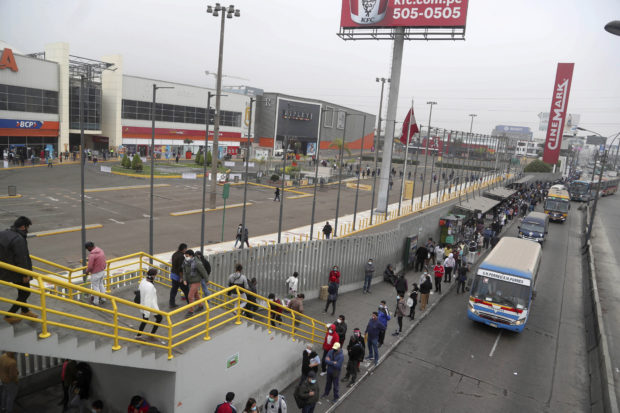Peru giving up on virus measures in face of sinking economy
LIMA, Peru — On the same day that the Peruvian government announced another grim increase in the number of coronavirus infections, thousands of people packed together in hourslong lines outside shopping malls for a chance to buy a new sweater, sneakers or computer.

Hundreds of people wait in line outside of at Mega Plaza mall in Lima, Peru, Wednesday, June 24, 2020. Thousands of people crowded in hours-long lines after Peru’s government ignored scientific warnings and opened the country’s 90 shopping malls this week in the middle of one of the world’s worst outbreaks of coronavirus. (AP Photo/Martin Mejia)
Peru — which has reported the world’s sixth-highest number of cases in a population of just 32 million — has decided to ignore scientific warnings and opened many of the country’s largest shopping malls this week.
The government had been following international advice on fighting COVID-19 — enforcing a strict stay-at-home order for three months — but the measures failed to prevent one of the world’s worst outbreaks, and the country now faces one of the region’s deepest recessions on top of rising death rates.
The official unemployment rate sits at 13%, and one university study estimates that the country will lose 4.2 million jobs by the end of the year — figures that don’t even capture the large part of the economy that is informal.
Thousands of community-run soup kitchens have popped up, providing cheap meals for neighbors who pool resources because they can no longer afford to feed themselves on their own.
“It’s hard, and sad, when you have kids and there’s no food,” Yeni Anco, a 46-year-old mother of seven, whose husband sells face masks on the streets of Lima. “A bigger kid can take it, but a little one can’t.”
Article continues after this advertisementSo now, Peru is prioritizing commerce over public health, and hoping for the best. Reopening malls is the largest step the government has taken so far, but by June 30, all anti-virus measures will be removed.
Article continues after this advertisementWith 402 stores, including H&M and Zara, the Lima MegaPlaza has a normal capacity of 30,000 people. Management was limiting shoppers to half that number under government orders this week — but the result was thousands of people in closely packed lines outside.
More than 2,000 waited Tuesday afternoon in lines that snaked from the main entrance of the mall. Almost all wore masks, but many did not respect the 3-foot (1-meter) distancing mandated by the Peruvian government — already less than the 6 feet advised elsewhere. Street vendors, taxi drivers and beggars wandered among the crowds.
Two police officers watched passively.
“With all these people packed together, I want to get out of here,” said Evelyn García, a 35-year-old beauty-products saleswoman waiting to buy a laptop waiting outside the mall. Despite her concern, she said, she needed the computer to work from home.
“I’ve been suffering with an old computer for 100 days,”‘ she said, rubbing disinfectant on her hands. “This is the only solution I have right now.”
Chilean company Parque Arauco, owner of MegaPlaza and 20 other Peruvian malls, said it was cooperating closely with local authorities to ensure compliance with health rules outside its facilities.
Before entering the mall, each shopper had their temperatures taken and their hands and shoes disinfected. Children are barred from the malls and playgrounds, food courts, and other public areas are closed.
Still, epidemiologists said reopening Peru’s malls as the country regularly reports around 4,000 new cases every day is virtually guaranteed to accelerate infection.
“Outside the malls there’s no control and lots of people gathered, desperate to shop,” said epidemiologist Juan Astuvilca, dean of the Lima College of Medicine.
Peru was the first country in Latin America to impose widespread quarantine, which began on March 16. But with nearly half the working population of 16 million in informal jobs like construction or street vending that don’t have benefits or the ability to work from home, millions defied the order, laboring to feed themselves and their families.
After decades of underinvestment in public health, the epidemic’s spread swiftly became overwhelming. On Tuesday, intensive care units in Peru were nearly 88% occupied. In all, more than 8,400 people have died, according to a tally by Johns Hopkins University that almost certainly understates the toll.
“Hospitals are on the verge of collapse,” said epidemiologist Ciro Maguiña, a professor of medicine at Cayetano Heredia University.
The government, however, says that the number of new infections appears to be flattening — despite reporting 3,879 new cases on Wednesday.
So, faced with widespread discontent and an expected 12% drop in gross domestic product this year, President Martín Vizcarra began a gradual loosening of quarantine and curfew measures last month.
Opening the malls is the latest and biggest step. Owned mostly by powerful regional conglomerates, Peru’s malls provide jobs for some 180,000 people.
Vizcarra said the urgent need to restart the economy meant that every Peruvian would be responsible for helping to manage disease, rather than relying on government controls.
“Everyone has to make sure that everyone respects social distancing,” Vizcarra said in a public appearance Monday. “We’re reopening, but trusting in Peruvians’ sense of responsibility.”
But Maguiña, the epidemiologist, said that would not be enough: “If they don’t implement better controls, we’ll probably have more infected and more dead.”
gsg
For more news about the novel coronavirus click here.
What you need to know about Coronavirus.
For more information on COVID-19, call the DOH Hotline: (02) 86517800 local 1149/1150.
The Inquirer Foundation supports our healthcare frontliners and is still accepting cash donations to be deposited at Banco de Oro (BDO) current account #007960018860 or donate through PayMaya using this link.